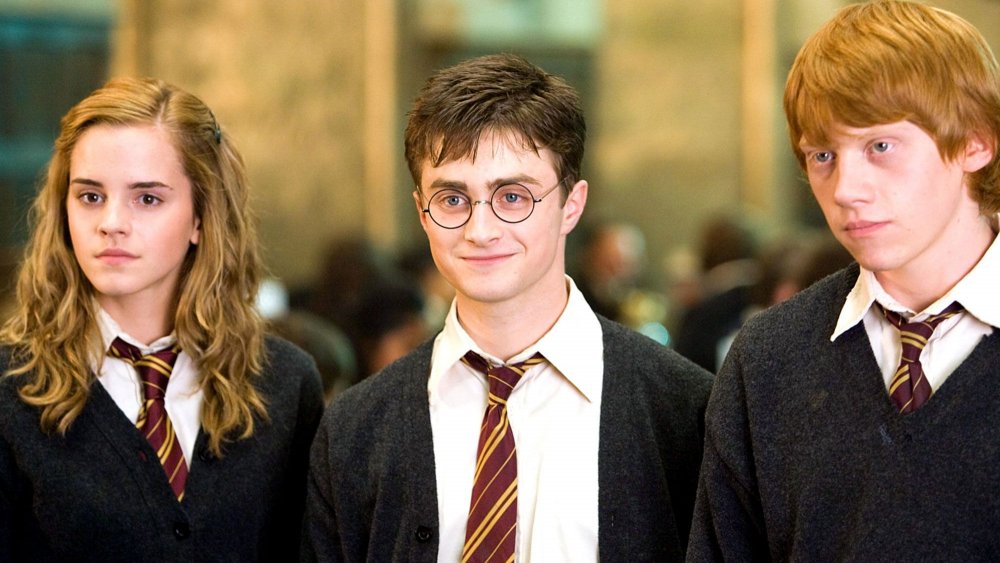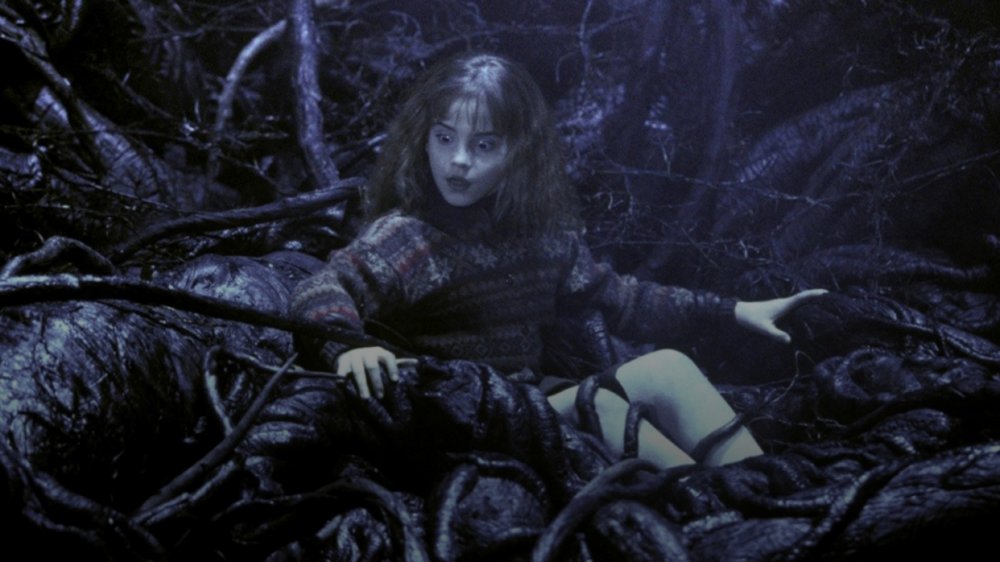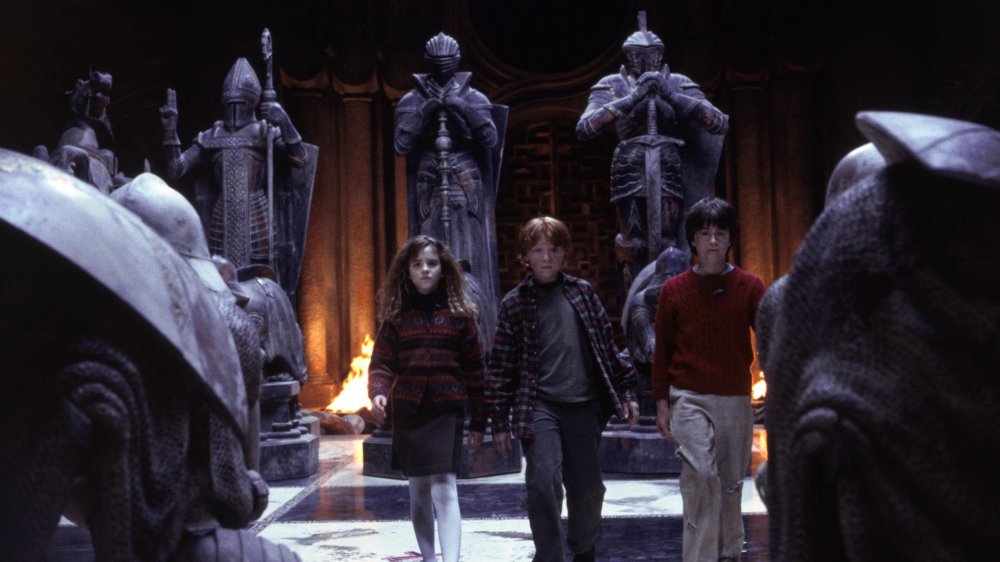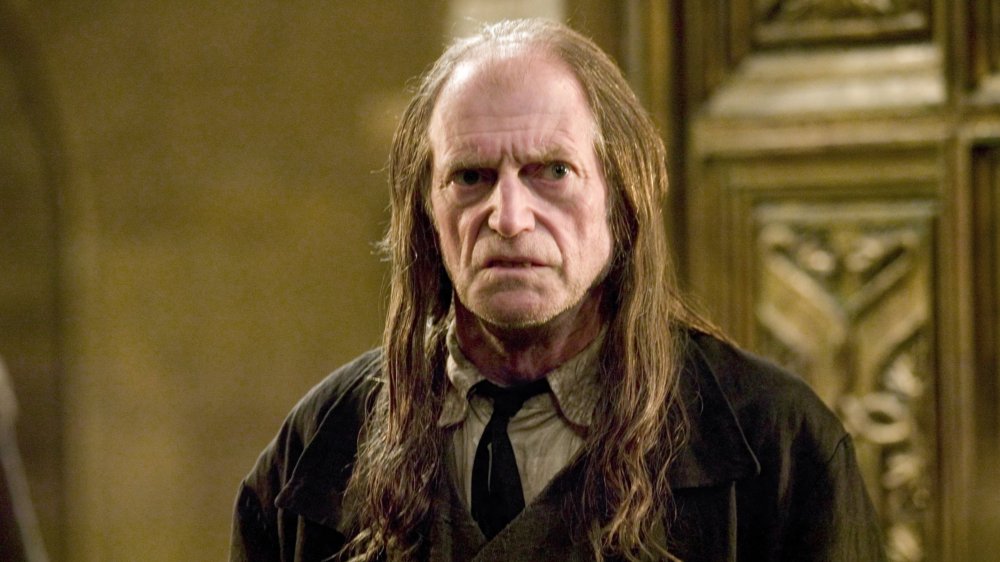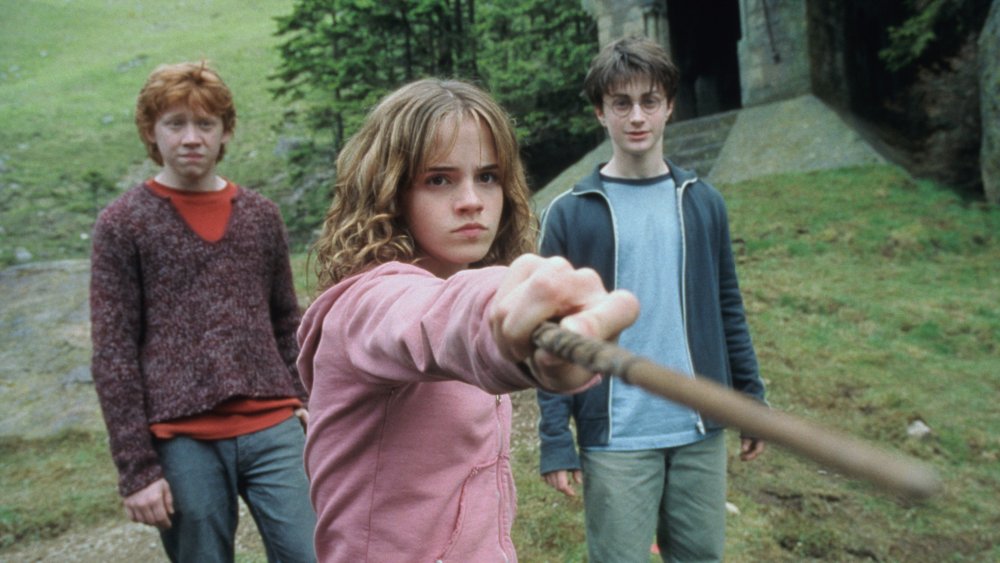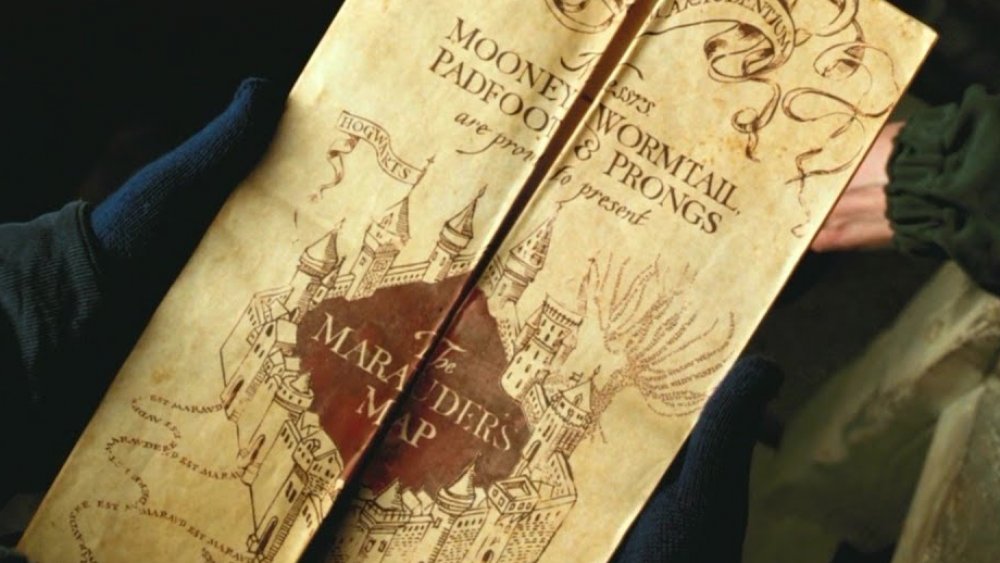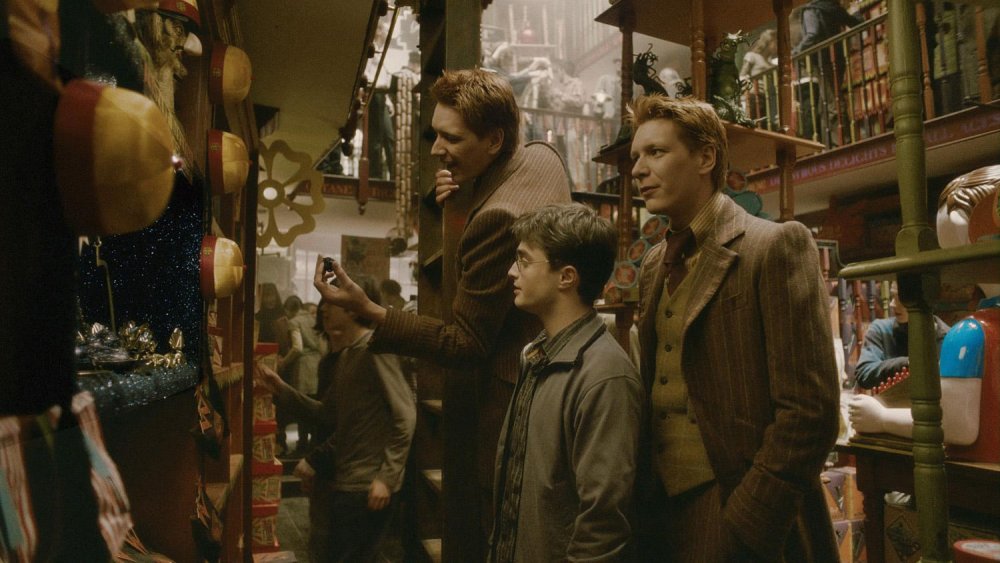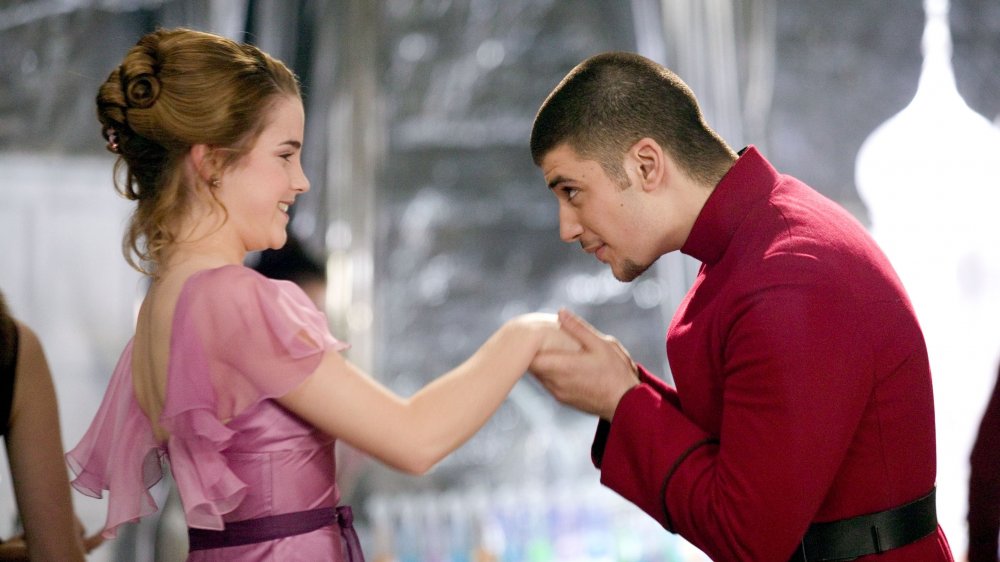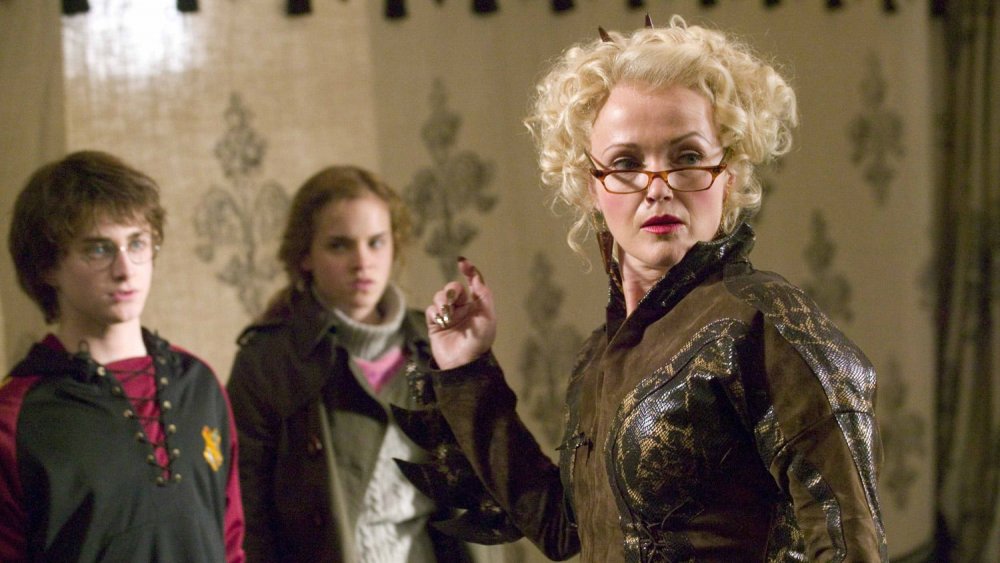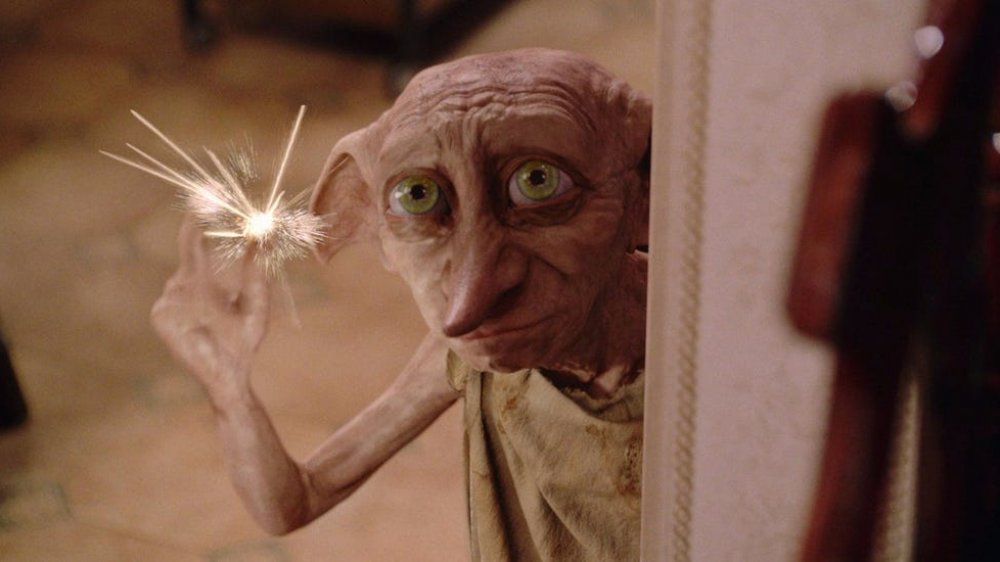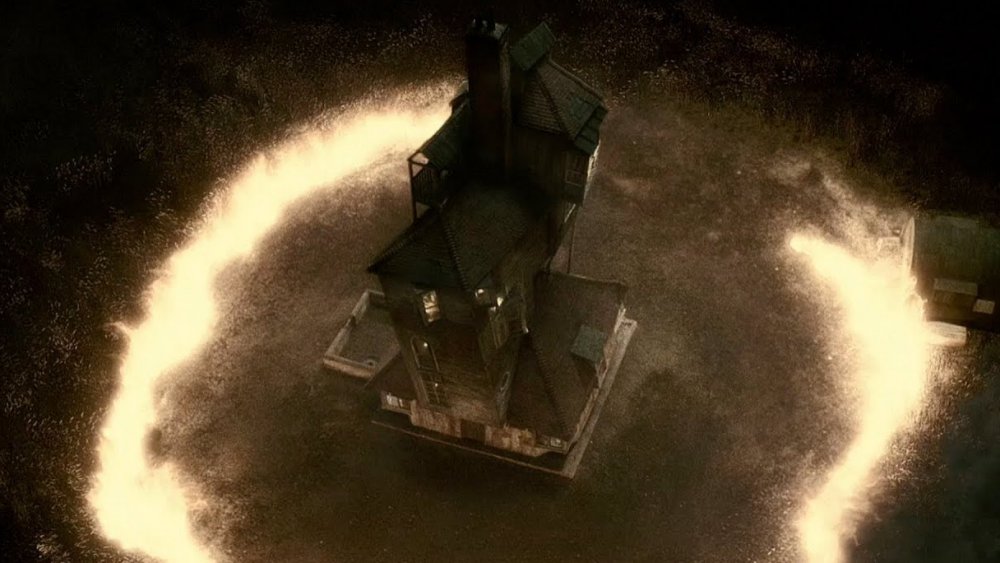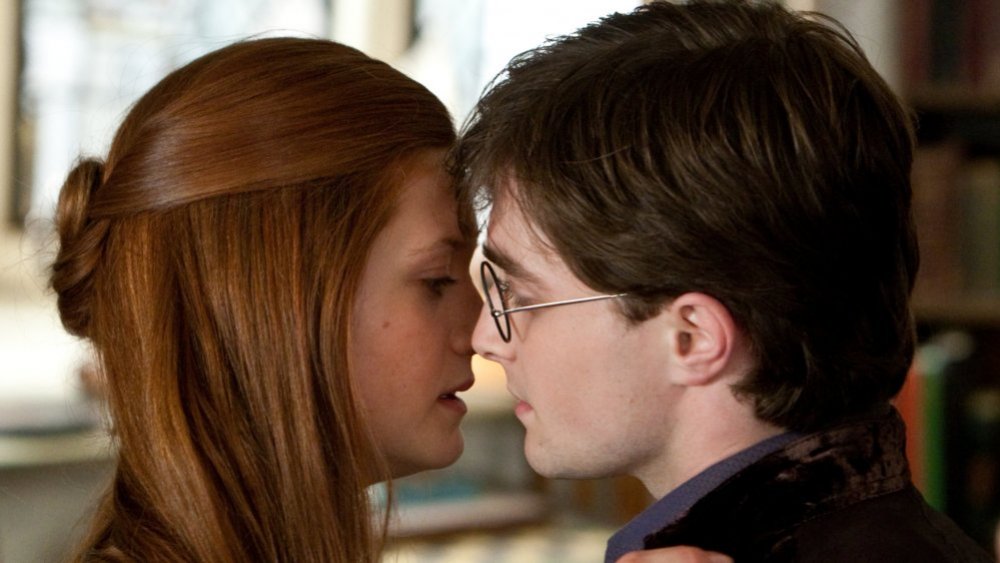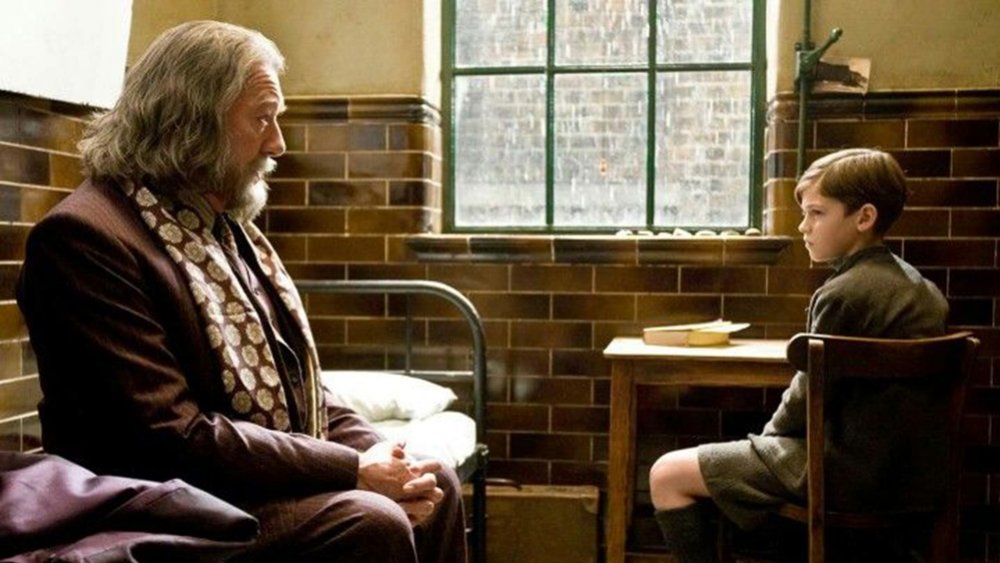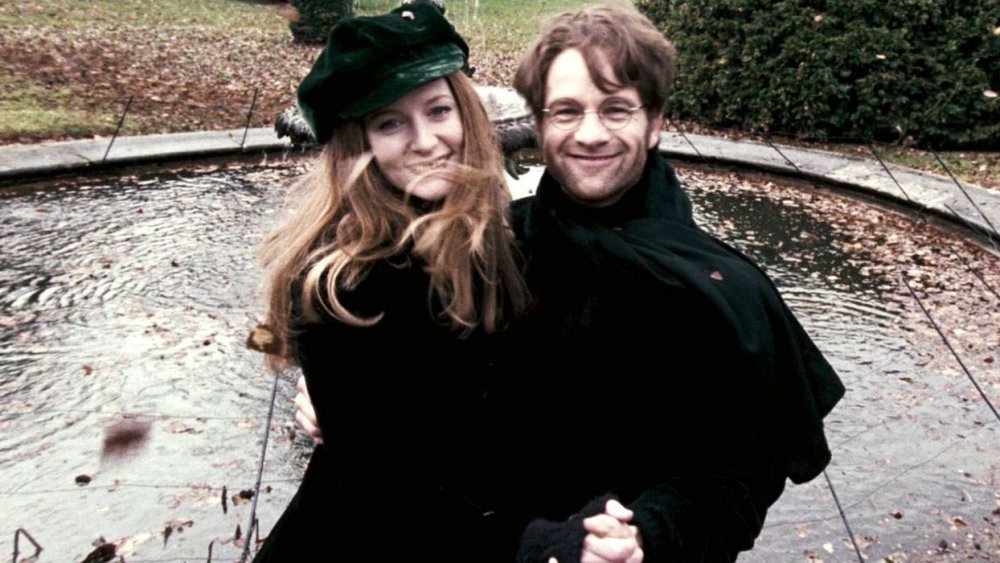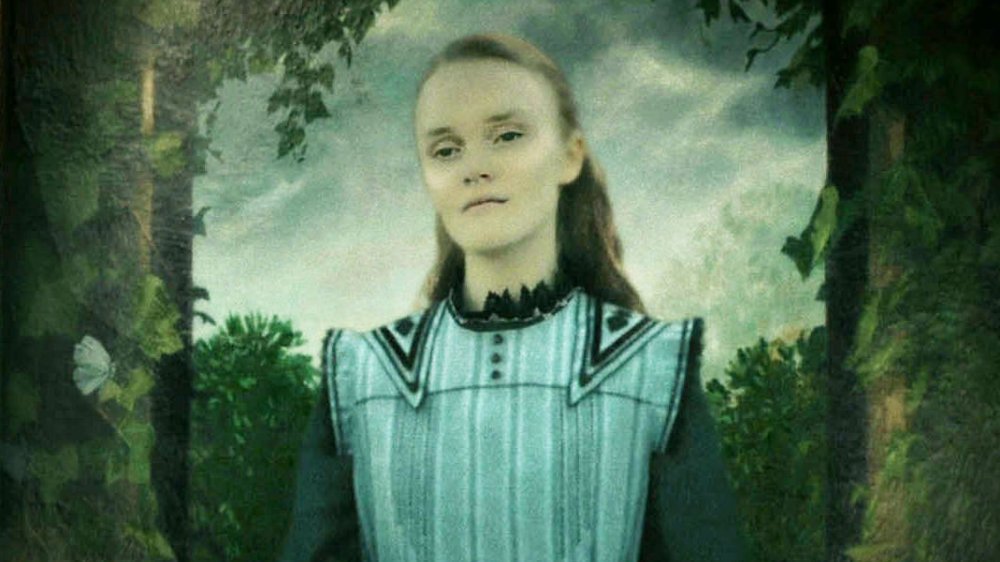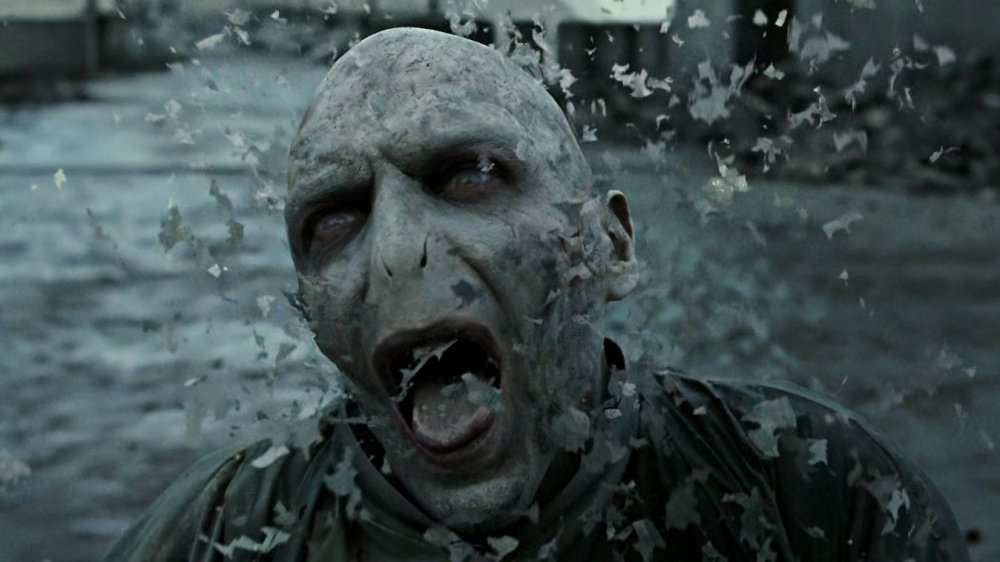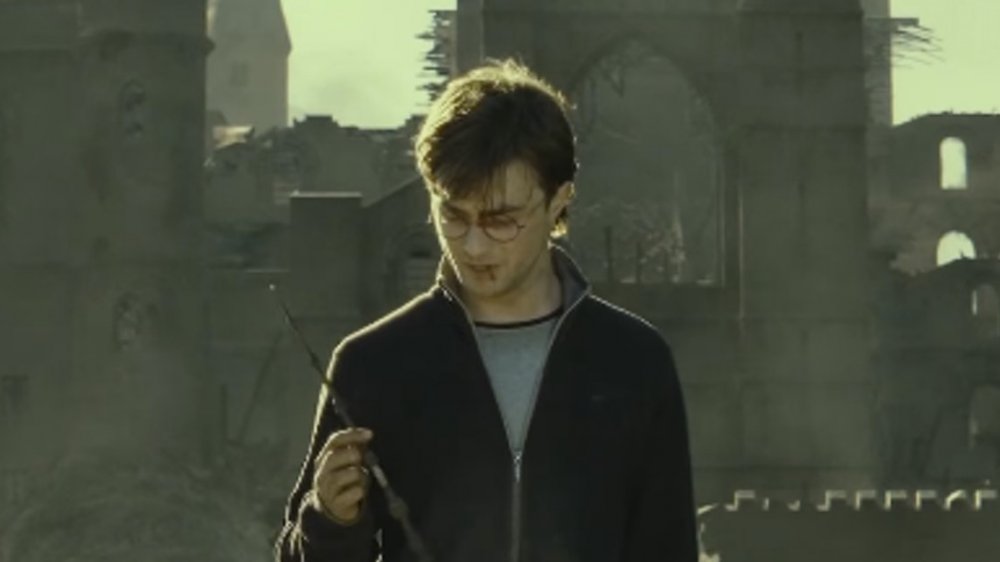Differences Between The Harry Potter Books And Films That Got Fans Talking
Adapting any popular book series is a huge challenge, and when it came time to bring the Harry Potter books, written by J.K. Rowling, to the big screen, Warner Bros. had a herculean task before them. With a revolving door of directors that included Chris Columbus (Sorcerer's Stone and Chamber of Secrets), Alfonso Cuarón (Prisoner of Azkaban), Mike Newell (Goblet of Fire), and David Yates (Order of the Phoenix, Half-Blood Prince, and both Deathly Hallows films), the series cast Daniel Radcliffe as the young boy wizard destined for greatness, alongside Rupert Grint and Emma Watson as his best friends Ron Weasley and Hermione Granger, and a whole slate of venerated British actors.
However, when you consider how long and intricately plotted Rowling's books were to begin with, it stands to reason that changes would be made from page to screen. Here are some of the biggest differences between the Harry Potter books and movies that really got fans talking.
Hermione loses her head
In Sorcerer's Stone, Harry, Ron, and Hermione spend the entire book and film trying to figure out the vast mysteries of a tiny but incredibly valuable magical artifact known as the Sorcerer's Stone, which can bless the owner with both gold and eternal life. Ultimately, it turns out that Voldemort (played in the later films by Ralph Fiennes) is after the Stone as well in his quest to regain human form, and by using a hapless new Hogwarts professor as a host, Voldemort gets pretty close: At this point, only Harry, Ron, and Hermione can stop him.
The rest of the Hogwarts faculty has set up a varied magical obstacle course to protect the Stone, but thanks to the trio's diverse range of smarts and talents, Harry makes it through — though in the books, Hermione almost botches the entire thing immediately. The smartest witch in their year, Hermione correctly identifies a plant — Devil's Snare — that's strangling Ron and Harry but panics, saying she can't defeat it with fire because there's "no wood." Ron retorts, "Are you a witch or not?!" and Hermione summons flames, which leads to a callback later in Deathly Hallows, where Hermione turns the tables on Ron as he forgets an obvious magical solution to a problem. In the films, Hermione creates fire immediately, which takes away an important and flawed side of her onscreen character.
Sorcerer's Stone is missing one of its smartest scenes
After Ron sacrifices himself in the Sorcerer's Stone quest and is left injured, Harry and Hermione are forced to continue on alone, and in the books, they progress into a challenge set by Hogwarts' brilliant yet cold Potions master, Severus Snape (played in the films by Alan Rickman). Lined up in front of them is a series of bottles, some of which contain poison or nettle wine but two of which are important: Fire now surrounds them on both sides, and one bottle will move a single drinker toward the Stone, while the other will let the drinker return to previous rooms.
Hermione might lose her cool during stressful situations, but as a deeply logical person, she handily solves Snape's difficult puzzle. In the books, she's rewarded with House points for her victory. However, the movies leave this scene out entirely, which is puzzling, considering that it robs this important character of her biggest moment during the quest for the Stone.
Squibs remain offscreen
Most Harry Potter movie fans are familiar with the concept of Muggles — non-magical people with little to no knowledge of the wizarding world — but if you've only seen the movies, you might not know about Squibs. Squibs are kind of the opposite of Muggles, in that they're non-magical children born to wizarding families. Even in pureblood families, Squibs can occur and are a source of shame to wizarding parents.
The Harry Potter series doesn't focus on Squibs particularly often, but two relatively prominent characters are Squibs, a fact that the film series never acknowledges. Argus Filch (David Bradley), the caretaker of Hogwarts, is a Squib, which is confirmed when Harry finds a pamphlet for a "Kwikspell" magic course in his office in Chamber of Secrets, which might explain his resentment toward the entire student body of Hogwarts. The other is Arabella Figg (Kathryn Hunter), the neighbor of Harry's Muggle relatives, who ends up helping him out of a dire situation during Order of the Phoenix. Squibs might not seem vital, but they're a major part of the wizarding world in the books and are completely left out of the films.
Hermione and Ron are completely off in Prisoner of Azkaban
As the film series progressed and different directors signed on, the characters went through transformations depending on which director was at the helm, and those shifts really affected Ron and Hermione in Alfonso Cuarón's Prisoner of Azkaban.
Throughout the film, Ron, who can be sarcastic and snippy but has a sweet side, is kind of a jerk, especially in the way he treats Hermione. During one of Snape's classes, when the cruel professor calls Hermione an "insufferable know it all," Ron sticks up for her in the books and gets a detention for his trouble. In the movies, he agrees with Snape. To make matters worse, at the climax of the book, when the trio faces off with accused murderer Sirius Black (played in the films by Gary Oldman), Ron stands on a broken leg to defend his friend, creating a touching moment. In the movie, Hermione gets the line, and it's nothing more than a throwaway.
In contrast, Hermione, who is secretly taking every class Hogwarts offers during her third year with the help of a Time Turner, is self-assured and stress-free in the films, but in the books, the stress nearly breaks her. Ron and Hermione are great characters no matter what, but the third movie really distorts what's amazing about both of them.
The Marauder's Map remains a mystery in the movies
Partway through Prisoner of Azkaban, Harry receives an invaluable gift from the Weasley twins — the Marauder's Map, which, when summoned, tells the reader every single secret of Hogwarts, displaying where everyone is within the castle and detailing every secret passage in and out of the school. However, the movie omits one huge detail about the map: Harry's father James wrote it.
While James was at Hogwarts, he crafted this tricky, brilliant map with his best friends Sirius Black, Remus Lupin (David Thewlis), and Peter Pettigrew (Timothy Spall), using their nicknames so that the map tells readers it was created by "Moony, Wormtail, Padfoot, and Prongs." However, if you've never read the books, you likely have no idea that this amazing creation which falls into Harry's lap was actually his father's invention and, therefore, his birthright. Harry hangs onto the map for the remainder of the series, but the identity of the Marauders remains a mystery to casual moviegoers throughout all the films.
Weasley's Wizard Wheezes has a mysterious benefactor
Throughout both the books and the films, Ron's twin brothers Fred and George Weasley (James and Oliver Phelps) serve as comic relief. As Hogwarts' pranksters in chief, the two are always creating some sort of mischief, and ultimately, they drop out of Hogwarts before they finish their seventh and final year to open a joke shop in Diagon Alley. To nobody's surprise, the twins' venture, which they name Weasley's Wizard Wheezes, is a huge success, but in the movies, one huge question remains: Who gave them the startup money for such an expensive business?
If you've read the books, you know the answer. After taking home the entirety of the prize money for the Triwizard Tournament — which ends in tragedy and the death of fellow Hogwarts champion Cedric Diggory (Robert Pattinson) — in Goblet of Fire, Harry doesn't want the 1,000 Galleons he receives. By giving it to Fred and George, he finances their future, but in the movies, you never see this act of generosity.
Viktor Krum transforms from page to screen
After three books set entirely at Hogwarts, Harry gains a much broader glimpse of the wizarding world in Goblet of Fire when he attends the Quidditch World Cup with Hermione and the Weasley family before he begins his fourth school year. At the match between Bulgaria and Ireland, the trio get their first glimpse of wunderkind Quidditch player Viktor Krum, who ends up joining them at Hogwarts to serve as a Champion in the Triwizard Tournament for his school, Durmstrang. Talented on the Quidditch field but shy and reserved in person, Krum keeps to himself but ultimately ends up wooing Hermione, infuriating Ron.
However, in the films, Stanislav Yanevski's Viktor Krum is a buff, confident jock who seemingly asks Hermione out with no problem and isn't shy in the slightest. Characters are often adjusted during adaptation, but Krum radically transforms from the page to the big screen.
Rita Skeeter's big secret remains under wraps
Throughout Goblet of Fire, Rita Skeeter (Miranda Richardson), a gossipy reporter for the wizarding world's Daily Prophet, wreaks havoc on Harry's life with a series of mostly fabricated and incredibly invasive stories about his past, his love life, and his controversial participation in the Triwizard Tournament. These stories feature much more prominently in the books than they do in the films, and in the books, they invite an enormous question: How is Rita getting all of her inside scoops, many of which concern overheard conversations on the Hogwarts grounds?
As Hermione later discovers, Rita is an unregistered Animagus — referring to a witch or wizard who can transform into an animal at will — who can turn into a beetle, which, as a secret, is against wizarding law. Armed with that knowledge, Hermione blackmails Rita for the remainder of the series, but moviegoers never even find out Rita's big secret.
Dobby the house-elf gets downplayed
As Chamber of Secrets opens on both the page and screen, Harry is taken aback when Dobby, a rogue house-elf, shows up at his aunt and uncle's Muggle house with a warning, begging the young wizard to not return to Hogwarts. For the rest of the year, Dobby keeps trying to "save" Harry, though he often ends up endangering Harry's life, but when Harry realizes Dobby's true motives at the end of the year, the two form a long-lasting bond and friendship.
However, in the films, two of Dobby's most helpful moments are given to another character. In Goblet of Fire, when Harry is stuck trying to figure out the second task in the Hogwarts lake, Dobby provides him with gillyweed, which can help him breathe underwater. In the film, Neville Longbottom (Matthew Lewis) gets this job. Then, in Order of the Phoenix, Dobby helps Harry discover the Room of Requirement when he needs a space to practice Defense Against the Dark Arts, but in the film, Neville comes to the rescue again. Dobby returns for later films, but some of his big moments are simply handed to Neville in the meantime.
The Burrow's burning is out of place
During the sixth film, director David Yates apparently decided that he needed to add some drama to the narrative. However, in doing so, he drastically changed the entire story for the worse. In the middle of Half-Blood Prince, viewers are shocked and appalled when the Weasley family home, the Burrow, is torched by several Death Eaters, including the insidious Bellatrix Lestrange (Helena Bonham Carter), as the Weasleys and Harry watch in horror.
In the books, this never happens, and burning down the Burrow has serious implications for Deathly Hallows, where the home plays host to the Order of the Phoenix as well as a wedding crucial to the plot. Beyond that, the entire scene feels like an excuse to include Bonham Carter, whose character, Bellatrix, only appears in the book during a scene with Snape and her sister which didn't make the cut. Adding action scenes can help move a film along, but burning down a huge part of the narrative — especially when it never happens in the books — simply doesn't work.
The major romances change a lot from the books to the movies
When romance becomes a part of Harry Potter, it changes everything, and in Half-Blood Prince, Harry is shocked when he develops un-brotherly feelings for Ginny (Bonnie Wright). In the books, readers learn all about Harry's enormous crush on Ginny, which culminates in a passionate, surprising kiss after that year's Quidditch final, shocking Harry, Ginny, and everyone around them. It takes Ron and Hermione a little longer to get together, but in Deathly Hallows, when Ron tries to protect the house-elves of Hogwarts during battle, Hermione is overcome with emotion, flinging herself at him just as the trio prepares to fight off Voldemort.
However, in the films, these kiss scenes carry much less weight. Without Harry's perspective, his crush on Ginny seems relatively random, and the chemistry between Wright and Radcliffe certainly leaves a lot to be desired. Meanwhile, Ron and Hermione's kiss has nothing to do with elf rights and comes across awkward as well, likely because Grint and Watson were so nervous. Harry Potter is filled with great romances, but you might not be able to tell from the films alone.
Voldemort's backstory is incomplete
During Half-Blood Prince, as Dumbledore and Harry attempt to understand the Dark Lord's lifelong obsession with mysterious Dark objects called Horcruxes, they investigate several different memories regarding Voldemort's past. While the film shows a young Voldemort — then Tom Riddle — as a young orphan given the chance to go to Hogwarts, as well as a compromised memory between Riddle and a Hogwarts professor, it cuts out some other key moments.
In the films, you never learn that after graduating, Riddle gave up several job offers to seek rare magical objects at the Dark store Borgin and Burkes, and after that, he returns to Hogwarts to ask Dumbledore for a job. These key memories help tell Harry where and what Voldemort's Horcruxes might be, and although it makes sense that they were left out of the film's long runtime, the story isn't complete without them.
The Marauder's ages are quite off
Throughout the entire film series, Harry sees frequent images of his late parents, James and Lily Potter, and even gets to meet their school friends Sirius, Lupin, and Pettigrew (the last of whom betrayed the Potters to Voldemort), giving him a glimpse into what their lives might have been like. However, his glimpses don't make a ton of sense, in that all of the Marauders — plus Lily — are the wrong age.
James and Lily, who got married right after Hogwarts, were in their very early twenties when they died, but every time Harry sees their images, they look like they're in their early forties. As for Lupin, Pettigrew, and Sirius, they're all played by legendary British actors, but they're also too old, since all of these people were in the same year at Hogwarts. This change might not seem important, but it takes away the added tragedy of how young James and Lily were when they were murdered.
Ariana Dumbledore is absent
Right up until his death in Half-Blood Prince, Dumbledore plays his cards incredibly close to the chest, including the tragic tale of his younger sister, Ariana. In the books, Harry only hears the entire story from Dumbledore after he sacrifices himself to Voldemort in Deathly Hallows and discovers that Ariana, who had trouble suppressing her magic, accidentally killed Dumbledore's mother and required constant care and attention. Later, in a duel between Dumbledore, his brother Aberforth, and Dumbledore's friend-turned-enemy Grindelwald, Ariana was killed, and none of them knew who cast the spell that caused her death.
This heartbreaking moment, the darkest of Dumbledore's life, is also his biggest secret, yet in the movies, it's nowhere to be found. Ariana's portrait is still present as a passageway from Hogsmeade into Hogwarts, but the true story of Dumbledore's deepest regret, which rounds out his character, is simply missing entirely.
Voldemort's death is drastically different
As Deathly Hallows draws to a close, the moment audiences anticipated for years finally arrives when Harry and Voldemort face off one last time, with Harry as the victor. However, the scene differs greatly between the book and film, distorting its original intention.
In the book, Harry, returning from the dead, corners Voldemort in Hogwarts' Great Hall and explains his downfall to him in great detail, ultimately killing Voldemort now that none of the Dark Lord's Horcruxes, which contain fragments of his soul, remain. Defeated, Voldemort falls to the ground shrunken and powerless as any man would, and Hogwarts celebrates around him. However, the film makes a bizarre spectacle out of Voldemort's death as he explodes into ash for some unclear reason, which goes against the original point: Voldemort, without magical protection, died just like any other man, and he was never actually as special as he thought or believed.
The Elder Wand's fate
Throughout Deathly Hallows, everyone from Harry to Voldemort to Dumbledore seems to be searching for the Elder Wand, rumored to be the most powerful wand in existence. Though it originally belongs to Dumbledore, Voldemort removes it from his tomb, but the wand never obeys him in the way that he wants. Due to a complicated bit of wandlore, the wand actually belongs to Harry, giving him an advantage over Voldemort. However, the Elder Wand's fate changes between the book and the movie.
In the book, Harry, who vows to return the wand to Dumbledore's tomb after he defeats Voldemort, uses the powerful Elder Wand to repair his own beloved wand — which was broken during a previous battle — reuniting him with his preferred wand. However, in the movie, Harry dramatically snaps the Elder Wand in half without repairing his wand, erasing that nice bit of continuity entirely.
